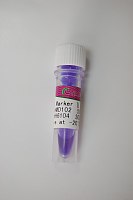Printing DNA Microarrays Using the Biomek 2000 Laboratory Automation Workstation
互联网
599
DNA microarray technologies have been developed as a high-throughput means to study transcriptional regulation (for a recent review, see ref. 1 ). Large numbers of DNA samples (either complete cDNAs or ESTs) are immobilized as very high-density arrays on solid surfaces, typically glass. Microarray analysis is conceptually similar to that of a reverse dot blot, whereby the tethered “probe” DNA samples comprising the array are hybridized with fluorescently labeled “targets” produced from mRNAs isolated from tissues of interest (for a discussion of terminology, see ref. 2 ). The microarrays are then scanned to quantitate the signals produced by the hybridization of the labeled targets to the individual array elements. In this way, parallel monitoring can be done for all transcripts represented in the array. Direct comparison of gene expression patterns between two tissues, or two different experimental conditions, is done by simultaneous hybridization of corresponding targets labeled with different fluorochromes. This approach has been successfully employed to study gene expression in both prokaryotes and eukaryotes (1 ,3 –10 ).






